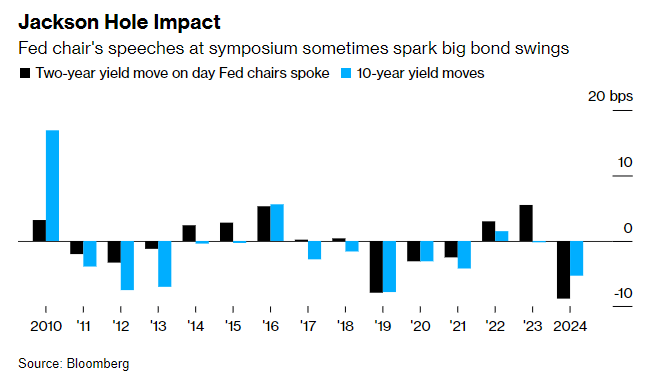This week, bond traders are at a critical juncture in their bet on the Fed’s imminent interest rate cut – Federal Reserve Chair Powell will make an important statement regarding the economic outlook.
The speech delivered at the Federal Reserve Bank of Jackson Hole’s annual conference on Friday will be a decisive moment for the Treasury bond market. Currently, the market is almost certain that the Federal Reserve will cut interest rates by 25 basis points next month, and expects at least one more rate cut before the end of the year. In recent years, Powell often uses this occasion to release policy signals that shake the market, and this speech may have historical significance.
Although the recent unexpectedly strong inflation data have made some economists hesitate, traders are convinced that the weak employment market has paved the way for the Federal Reserve to shift to a dovish stance. The market generally expects that Powell will not overturn the expectation of a rate cut next month, but may remind investors that the policy decision on September 17 will still depend on the economic data before the meeting and it needs to be confirmed that the employment market continues to cool down and inflation is under control.
“He has the ability to make moves that could impact the market, but I’m not sure if he will do so,” said Kelsey Berro, an executive director of fixed income at JPMorgan Asset Management. “Bond market pricing still aligns with an environment where the economy is growing below trend and achieving a soft landing. I don’t think they have sufficient reasons to dispute the market expectations.”
Boosted by the weak employment data in July and the expectation of a rate cut, the yields of US Treasury bonds of all maturities generally declined in August. Among them, the yield of the two-year bond led the decline. Currently, the yield curve is steepening, with the two-year yield remaining around 3.75%, not far from the recent lows.
Variations in the Central Bank’s Annual Conference
This background made the Jackson Hole conference highly anticipated. Three years ago, Powell warned that fighting inflation would bring pain, causing short-term yields to soar; at the previous year’s conference, he hinted at preparing to lower interest rates from their 20-year high, and the two-year yield promptly dropped on that day. Then in September, the Fed indeed initiated the rate-cutting cycle, and in the first round, it implemented a significant 50 basis point move.
Some traders are preparing for a repeat of the past. Even after the producer price index rose sharply, there are still a large number of option trades betting on a 50 basis point rate cut next month. If the market prices the September meeting at a 40 basis point easing, these bets will yield substantial profits.
US President Trump and his cabinet members have been constantly pressuring for a rate cut, which has further fueled such bets. For months, Powell has consistently emphasized the need to observe the impact of tariffs on inflation, and has remained steadfast in this position despite the political pressure from the White House.
Scott DiMaggio, the head of fixed income at AllianceBernstein, said: “The Federal Reserve is under significant pressure. Their actions have been a bit delayed, but they have been waiting to assess the actual impact of tariffs on the economy and inflation.”
DiMaggio believes that the current data has reached the point where one can “say, ‘Yes, they should restart the rate-cutting cycle.’”
Definitive data
After the Jackson Hole conference, the market’s focus will shift to the August non-farm payroll data to be released on September 5th. This data will determine the path of interest rate cuts next month and may even trigger expectations of a 50 basis point aggressive rate cut. However, many investors have admitted that in the context of high producer inflation, the probability of such a large rate cut is relatively low.
Gregory Faranello, the head of interest rate trading and strategy at AmeriVet Securities, said: “We believe that everything will depend on the employment report. If the data is weak, the market will price in a 25 basis point rate cut, and Powell will not object to this.”
The current inflation remains stubbornly above the Fed’s target level. Moreover, the Trump tax reform bill may bring about fiscal stimulus. A too-rapid reduction in interest rates might stimulate the economy to overheat. Considering the pressure from the government on the Fed and the president’s action of replacing the labor statistics director, long-term bond investors may demand a higher risk premium.
Ed Al Hussainy, an interest rate strategist at Threadneedle Investment in Colombia, said: “Implementing an aggressive rate cut early means that the Federal Reserve must ignore the remaining upward risks in inflation and be certain that the unemployment rate will rise sharply.”
Post time: Aug-18-2025


